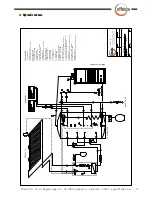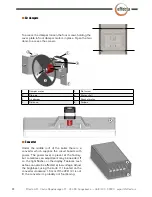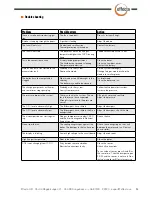
10
Effecta AB - Västra Rågdalsvägen 21 - 434 99 Kungsbacka - +46(0)300 - 22320 - export@effecta.se
Remember that during the first firing the boiler can feel sluggish and tough to fire. This is because
all the metal surfaces in the boiler are clean and cooled against the boiler water, the ceramics also
has some moisture that needs to dry. This uses energy from the wood, so the boiler can feel a bit
sluggish.
During the first firing, there is also a lot of oxygen in the water so it can sound as if it is simmering
in the boiler. This will go away when the system has been heated a few times.
The control switch should always be switched on. Place a handful of finely chopped dry wood at
the bottom of the loading compartment. Then take plenty of paper and place on top of the wood.
- Press button (A / startup) to start the fan and the charging pump, then ignite.
The lower door must be shut and the loading compartment door can be ajar but it can also be
closed. Test the way that suits you best. When the wood has ignited and there is a bed of embers,
the loading compartment can be filled with wood. Start by adding smaller pieces of wood at the
bottom and increase the size the further up in the loading compartment you go. Remember to stack
the wood carefully. It is important to get the best possible effect of the firing. When it has burned for
about 15 minutes, the flame will fill the bowl that you see in the inspection glass in the lower door.
The boiler burns at its best if the combustion is left on its own. It is therefore not appropriate to stir
the in the box during firing. If you open the door during firing, there is a risk of flashover in the box,
with poorer function as a result.
If you burn a lot of dry wood and have a strong draught in the chimney, you may hear a whispering
sound in the air dampers. This does not impair the boiler combustion or function, but to avoid this
you have to install a draft stabiliser that maintains a stable draught in the chimney.
NOTE: In case of a second insertion, there is a small risk of smoke emission. Therefore, wait until
the flue reaches a temperature just above 100°C. Open the door carefully to release any gas and
smoke from the loading compartment if necessary.
▀
The first firing
▀
Firing cycle
Start
Press the (START) button.
Fan and charging pump start,
the lambda probe is heated.
The dampers are adjusted
to Primary 70 % open and
Secondary 30 % open.
Operating phase
When the flue gas reaches
100°C , the dampers start to
regulate to achieve the set co²
level. The probe detects a value
every 20 seconds and adjusts
when the difference is + / - 0.5
% from the set value. If the co²
level must be increased, the
primary 10 % opens and the
secondary is reduced by 10 %.
If co² levels must be reduced,
the reverse occurs.
Reducing fire
When the co² level goes
down below 8 %, the
secondary damper shuts off
completely. And when the
flue gas temperature is below
90°C, the fan and circulation
pump shut off. The damper
closes completely. In order
to prevent downdrafts.
Safety
If the water jacket overheats
during firing, a protection will
stop the fan electronically
at 95°C. If the temperature
remains high, a mechanical
thermal protection is initiated.
This must be reset manually.
►
►
►
▬










































